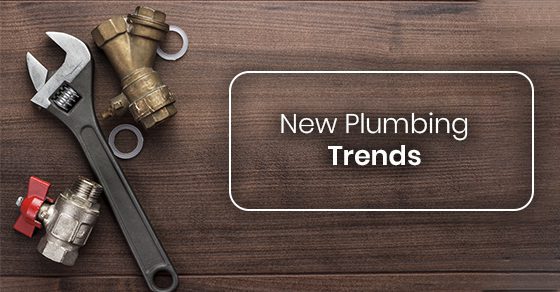
Discover the Latest Plumbing Trends
Smart plumbing technology, such as touchless faucets and toilets, are becoming increasingly popular. These products allow for hands-free operation and can be activated with a wave of the hand or a voice command. This reduces the need to keep up with germs and bacteria from continuously touching hardware. Smart plumbing also allows for precision control of hot and cold water, as well as reducing water waste due to its ability to regulate flow rates automatically. Additionally, smart plumbing is designed to be easily connected with other electronic devices in order to create an integrated home environment that is easy to manage.
Plastic piping systems are also gaining widespread use in new construction homes throughout the country due to their affordability and resistance to corrosion compared to traditional metal pipes such as copper or galvanized steel. Plastic pipes are more flexible than metal ones which makes them easier install without special tools or equipment. Moreover, plastic pipes require fewer joints making it quicker and easier for plumbers while potentially saving money on labor costs during installation. In addition, plastic pipes can have a longer life span than traditional materials if properly maintained making them an attractive option for homeowners seeking long-term solutions when it comes replace aging pipes in existing homes too.
Common Plumbing Materials

PVC (polyvinyl chloride) is the most common type of plumbing material used in residential and commercial applications. It is lightweight, durable, inexpensive, and easy to install. PVC pipes are available in various diameters and lengths to suit any project. PVC fittings are also available in many different shapes and sizes to fit any need. The smooth interior walls of PVC pipes help reduce friction which allows for higher water pressure resulting in better flow performance.
Copper piping is another popular plumbing material due to its long-term durability and resistance to corrosion. Copper has been used as a piping material since ancient times due to its malleability making it easier to shape than other materials such as iron or steel. Copper pipes come in a variety of sizes ranging from ¼” up to 2” or larger with copper tubing commonly used for hot & cold water lines, drain lines, gas lines, sprinkler systems and solar heating systems.
Galvanized steel piping is yet another type of plumbing material that was widely used until the mid-20th century when copper became commonplace due its longevity and cost effectiveness compared with galvanized steel pipe which corrodes over time leading eventually lead it needing replacement.
Water Conservation Technology

Smart Home Automation

Smart home automation can help homeowners keep up with the latest plumbing trends. For example, automated water shut-off valves can detect leaks in plumbing and automatically cut off the water supply, preventing costly water damage. Smart thermostats with sensors can also measure temperature and humidity levels in homes to prevent frozen pipes and other potential problems. Additionally, smart showerheads are equipped with sensors that adjust water pressure and temperature based on preferences programmed into the device, allowing homeowners to save energy while having a more comfortable shower experience. Homeowners can even use voice-controlled devices such as Amazon Echo or Google Home to control their home’s plumbing systems from anywhere in the house. This makes it easy for them to adjust settings without having to get up and physically do anything.
Advances in Pipe Repair
Innovation in pipe repair technology has made it possible for plumbing contractors to tackle complex repair jobs with much greater efficiency and precision. In the past, many repairs were done by trial and error, but now there are systems that can accurately diagnose the problem and provide a reliable solution. For example, epoxy lining is a cost-effective way to repair pipes without having to replace them entirely. This method involves injecting an epoxy resin into the damaged pipes, which seals up any cracks or breaks in the pipe walls and creates a new seamless barrier of protection. This means that instead of having to dig up large sections of pipe, plumbers can simply inject the epoxy resin into one small area and seal off any leaks or breaks quickly.
Advances in video pipeline inspection technology have also drastically changed how plumbing repairs are done today. Instead of having to dig up entire sections of pipe just to find out what’s wrong with them, plumbers can now use video inspection technology to see exactly what’s going on inside the pipes without damaging them or causing further damage. Video inspections allow plumbers to pinpoint exactly where problems are located so they can be fixed quickly and accurately without having to replace large portions of piping.
New Piping Designs

One of the most popular new piping designs is PEX tubing. This plastic material is extremely durable and flexible, making it perfect for limited spaces or hard to reach areas. It’s also resistant to corrosion, so it can be used in a variety of applications such as hydronic heating systems and portable water distribution lines. Additionally, due to its flexibility, PEX tubing can be quickly installed with minimal disruption to existing plumbing systems.
Another emerging design is stainless steel piping. This type of pipe offers durability and strength that makes it an ideal choice for industrial grade systems such as fire suppression systems or commercial kitchen sinks. Stainless steel pipes are also available with insulation which helps reduce heat loss during cold weather conditions. Finally, stainless steel pipes are much easier to install than traditional copper pipes because they come pre-cut and pre-bent into shapes that can fit into tight spaces without requiring extensive cutting or modifications.
Another type of piping that is becoming popular in residential construction is PVC pipe. This pipe has been around for many years but recent advances in technology have made it a more attractive choice over other types of pipes.
Conclusion


